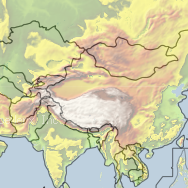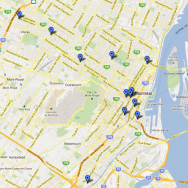 TileStream is an open source tile server developed by MapBox, which borrows extensively from their commercial MapBox tile server product. TileStream loads map layer packages created in the TileMill application, which are stored on the server as SQLite databases in the mbtiles specification/schema. On the other hand, Heroku is a cloud application platform that supports Python, Ruby, Java and Node.js apps, the latter of which TileStream is dependent upon. This post will show how to deploy a TileStream server on the Heroku cloud application platform, thereby allowing you to serve your map tiles using scalable infrastructure that can respond to fluctuations in the demand of your web maps. See the result here.
TileStream is an open source tile server developed by MapBox, which borrows extensively from their commercial MapBox tile server product. TileStream loads map layer packages created in the TileMill application, which are stored on the server as SQLite databases in the mbtiles specification/schema. On the other hand, Heroku is a cloud application platform that supports Python, Ruby, Java and Node.js apps, the latter of which TileStream is dependent upon. This post will show how to deploy a TileStream server on the Heroku cloud application platform, thereby allowing you to serve your map tiles using scalable infrastructure that can respond to fluctuations in the demand of your web maps. See the result here.
 Life as a grad student, as many of you already know, is a constant battle with completing assignments on time, keeping up the grades for future funding opportunities and getting enough sleep. My first semester in the Master of Spatial Analysis program is nearing its end in what seems like the shortest semester of school I’ve ever taken. During this time I have had the pleasure to strengthen some of my skills in the R language for statistical computing for the purpose of water quality trend analysis (SA8904 — GIS Project Management). This post will show how I have used R for water quality trend analysis, using publicaly available data from the USGS (due to a NDA that prohibits me to share my school work).
Life as a grad student, as many of you already know, is a constant battle with completing assignments on time, keeping up the grades for future funding opportunities and getting enough sleep. My first semester in the Master of Spatial Analysis program is nearing its end in what seems like the shortest semester of school I’ve ever taken. During this time I have had the pleasure to strengthen some of my skills in the R language for statistical computing for the purpose of water quality trend analysis (SA8904 — GIS Project Management). This post will show how I have used R for water quality trend analysis, using publicaly available data from the USGS (due to a NDA that prohibits me to share my school work).
 You can now purchase a copy: here!
You can now purchase a copy: here!
I guess we can call this part two of the global connectivity by flight experiment, which I have been working on the past couple of days. Once again, the data comes from openflights.org/data.html and is available for free to the public. It is a very detailed set of data that requires just a little bit of massaging to be usable in a desktop work environment. In this blog post I would like to take you through some quick helpful tips that should get you from downloading the data and cleaning it up to mapping it in ArcMap. In all honesty, I would have loved Continue reading »
 Lets talk about QGIS for a little bit before we go ahead and install it on our systems. QGIS is an open source GIS package that is under the GNU public license. It offers enough functionality for someone with a ArcInfo Student License (myself) to want to explore. The usage of QGIS in day to day tasks has me spending less time Continue reading »
Lets talk about QGIS for a little bit before we go ahead and install it on our systems. QGIS is an open source GIS package that is under the GNU public license. It offers enough functionality for someone with a ArcInfo Student License (myself) to want to explore. The usage of QGIS in day to day tasks has me spending less time Continue reading »
 I can think back and remember struggling with being able to utilize OpenStreetMap (OSM) data in a project of mine. I wanted a free source of information and geospatial data, where I was not bound to strict and limiting copyrights. OpenStreetMap offered a one-stop-shop for free and open geospatial data. At the time, I was most interested in utilizing their very detailed road network. However, I ran into many hiccups along the way, which ultimately deterred me from completing the project. Some time has passed and I have returned to said Continue reading »
I can think back and remember struggling with being able to utilize OpenStreetMap (OSM) data in a project of mine. I wanted a free source of information and geospatial data, where I was not bound to strict and limiting copyrights. OpenStreetMap offered a one-stop-shop for free and open geospatial data. At the time, I was most interested in utilizing their very detailed road network. However, I ran into many hiccups along the way, which ultimately deterred me from completing the project. Some time has passed and I have returned to said Continue reading »

 It’s been a while since I last posted on my blog! Very excited to be back =D. The fall university semester went by quickly due to an onslaught of projects, tests and my undergraduate thesis, which I am proud to say that I survived and completed with honours. This semester I started working for Dr. Claus Rinner (my thesis supervisor) on a web mapping application that utilizes some of the data from my thesis. All in all, a busy year for me at the university!
It’s been a while since I last posted on my blog! Very excited to be back =D. The fall university semester went by quickly due to an onslaught of projects, tests and my undergraduate thesis, which I am proud to say that I survived and completed with honours. This semester I started working for Dr. Claus Rinner (my thesis supervisor) on a web mapping application that utilizes some of the data from my thesis. All in all, a busy year for me at the university! As our trip to Montréal nears, Heather (my girlfriend) and I have been studiously keeping track of the places that we would like to explore. One thing is for sure, we are going to be more than prepared because we are using google fusion tables. May it be a raved about restaurant or a grocery store that is closest to our hotel, we have every place of interest accessible online as a map or in tabular format.
As our trip to Montréal nears, Heather (my girlfriend) and I have been studiously keeping track of the places that we would like to explore. One thing is for sure, we are going to be more than prepared because we are using google fusion tables. May it be a raved about restaurant or a grocery store that is closest to our hotel, we have every place of interest accessible online as a map or in tabular format.